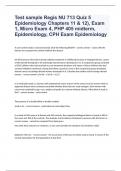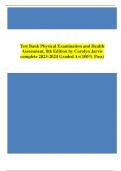Tentamen (uitwerkingen)
Test Bank - Anatomy and Physiology 11th Edition (Patton 2023) Chapter 1-48, Complete Questions and Answers (A+).
Test Bank - Anatomy and Physiology 11th Edition (Patton 2023) Chapter 1-48, Complete Questions and Answers (A+).
[Meer zien]












